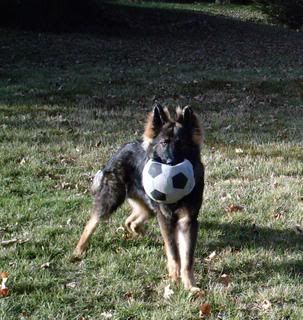Thanks for the compliment Howard.
If the dog is being worked by a person with any type of equipment on he is NOT being worked in civil, period.
It is possible to work the dogs defensive drives with equipment on however. What I like to do is shift the dogs gears back and fourth from prey to defense. I as the helper control this, the dog merely reacts to me and he reacts in prey or defense.
I start off by moving with the sleeve in sight and I may pop the whip, this puts the dog in prey
http://smg.photobucket.com/albums/v679/cjduhon/?action=view¤t=IMG_0050-1.jpg
Then I stop and square up with the dog angling my body so that the dog sees he has to deal with the man to get to the sleeve, sorta like the man is protecting the sleeve, there is no whip popping at this time, but the whip is held in a stick like position in a threatning manner, eyeing the dog hard, and pausing with no moment
http://smg.photobucket.com/albums/v679/cjduhon/?action=view¤t=IMG_0049.jpg
Once the dog gives good forward aggression and deep barks, he has flushed his prey and stopped his prey from stopping to defend himself and now has the prey on the move again
http://smg.photobucket.com/albums/v679/cjduhon/?action=view¤t=IMG_0046-1.jpg
Then give the dog some missed bites on purpose, this builds frustration for it's bite and increases tenacity and explosiveness
http://smg.photobucket.com/albums/v679/cjduhon/?action=view¤t=IMG_0054.jpg
Then when I give the bite I look away from him, and move away giving him his moment of glory and enjoying his dominance over his prey with the occassional stop, square up, raise stick very quickly then back to looking away, and moving away. This simulates prey in the wild. Prey in the wild, move and attract the preditor, they may stop briefly and attempt to fight off it's preditor that makes the dog have to fight or continue through a real threat, once they catch their prey, if it doesn't die instantly it may give them one last fight here and there as it dies, that would be the occassional stop and square up eye the dog raise the stick, but then go back to looking away and moving away from the dog while he holds his bite and work it.
The dog maybe tapped with the popping end of the whip, but mind you this isn't a slave days lashing with the whip, it is a controlled very quick pop on the front shoulders, and doesn't take much force. This lets the dog know that the helper/decoy means him harm and the engagement is serious. With the sleeve behind the helper, he clearly sees he has a fight with the helper putting him in defense. It should be noted that whip work is one of those things that should be done by those who truely know what they are doing, for reasons of not wanting to ruin a dog, making a dog stick shy, or actually hurting the dog. Actual contact with the whip does not need to happen often to get the point across. It should also be just forceful enough that the dog is not in pain, but understands it's unpleasant sensation. Again this is NOT whipping the dog kunta kintay style.
I prefer to shift the dog back and fourth from defense to prey because defense is stressful on the dog, and prey relieves the stress, it's a comfortable drive for the dog. This keeps the dog balanced IMO and keeps the work enjoyable and not just consistantly stressful.
Hope that explained a little
~CHRIS DUHON
COL Nathan R. Jessup for President Previous Topic
Previous Topic Index
Index Next Topic
Next Topic













 Top
Top




.jpg)